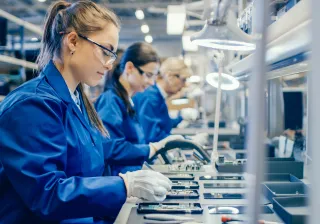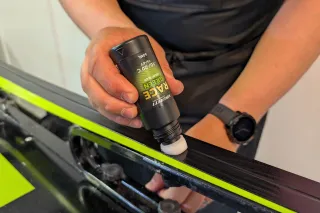A solution for manufacturing carbon negative concrete is hidden in a container standing next to a curing facility in a concrete plant in Hollola, Finland. In the container, carbon dioxide is forced into concrete blocks using an automated system. The process takes place at atmospheric pressure, and can easily be implemented into the existing manufacturing processes. VTT’s Senior Scientist Tapio Vehmas, who is in charge of the Carbonaide team, describes the development stages of this method. The process of commercialising it as a spin-off company is currently under way, supported by the VTT LaunchPad incubator.
Concrete is one of the largest single sources of carbon dioxide emissions, and VTT’s researchers have developed a solution for manufacturing carbon negative concrete products. They achieve carbon negativity by combining an efficient carbonation process with low-carbon binders. In 2019, VTT demonstrated how to produce carbon negative concrete by carbonating steel industry slags and side-streams from the paper industry. If a five-storey apartment building was constructed with carbon negative concrete manufactured with the Carbonaide method, carbon dioxide emissions would be reduced by 440 tonnes.
“So far, we have done five test runs in Hollola. The conclusion is clear: it is feasible to use our carbonation method in the concrete manufacturing process. This is a good start for setting up a start-up business”, Senior Scientist Tapio Vehmas says.
Concrete has a tendency to capture carbon dioxide. This process, called carbonation, causes the iron reinforcements to rust, which, in turn, breaks the concrete structures. “We turned this disadvantage into an advantage. The Carbonaide method makes the calculated carbon footprint of concrete manufacturing carbon negative: -60 kg per cubic metre of concrete. The carbon footprint of conventional concrete is approximately 250–300 kg per cubic metre”, Vehmas says.
VTT has studied concrete structures throughout its 80-year history. The carbonation of concrete has been an important research topic, and in the 1970s, ground-breaking research results were achieved. For the most part, research focused on problems caused by carbonation. The positive characteristics emerged when VTT developed the first concepts for carbon sequestration and utilisation in 2010. VTT was at the forefront of research again in 2016, when it was working on the value chain and utilisation of biogenic carbon dioxide in a European Regional Development Fund project.
“In this project, Research Scientist Sampo Mäkikouri explored where and how carbon dioxide could be used, and concrete emerged as one possibility. However, we continued to view carbonation as a disadvantage and wondered whether it was worth continuing with the research”, Vehmas reminisces.
The research took a turn as a result of the following insight: “The carbon dioxide that is diffused into the concrete element during the curing process can simultaneously create favourable conditions for the creation of carbonate minerals. When carbon dioxide is mineralised into concrete, abnormal reaction products are formed. Subsequently, we can use side streams that we have not been able to use in the past. Normally, the addition of calcium oxide does not produce anything, but if you use the carbonation process, calcium oxide turns into a reactive binder”, Vehmas explains.
The study progressed into the simulation phase, and its results were reported in the BioCO2 seminar in 2018. The idea was pushed forward almost by chance when Vehmas had an opportunity to present the concept to the VTT Board in VTT's research hall, 20 metres below sea level. “Make sure that this idea will not remain under ground for good”, a representative of the VTT Board said encouragingly.
Reaching Beyond the Obvious
Preparations for a new project started after the BioCO2 seminar. “We became excited about the new VTT slogan, Beyond the Obvious, and set our goals accordingly. We decided to develop carbon negative concrete without knowing exactly how to do it. We started experimenting in order to find out how carbon dioxide functions in concrete, how carboaluminates are formed, and how this process replaces cement and lowers the carbon footprint”, Vehmas says. With the help of VTT’s extensive expertise, they managed to develop the first concepts for binders that are capable of contributing to carbon negativity.
Solutions from steel industry slags
Experiments indicated that blast furnace slags formed as a side stream in the steel industry can also be effectively carbonated. Carbonated slags work as an excellent binder, and they lower the carbon footprint of concrete remarkably – even making it negative.
“This did not work out straight away, but we had to develop the material concept and look for appropriate activators. The binder’s final material combination consisted of slags, green liquor dregs and bio-ash”, Vehmas says.
The carbon negativity of the concept is based on the low carbon footprint calculated for blast furnace slags, which is currently 42 kg of carbon emissions per tonne of slags. The situation will change if more carbon emissions are allocated for steel industry slags.
Carbon dioxide into concrete elements at atmospheric pressure
“We applied for Research-to-Business funding from Business Finland in order to explore the possibilities for commercialising the method. It turned out that the use of waste and side streams can not be commercialised, and so we decided to focus on creating the best carbonation method in the world. While investigating the possibilities for commercialisation, we understood that the use of high pressure in the process would not be profitable, and it would constitute an obstacle to the industrial scalability of the process. “At the moment, our pilot equipment can carbonate products more efficiently than methods relying on overpressure. Moreover, the equipment operates at atmospheric pressure, which makes the process easy to commercialise”, Vehmas says.
Eventually, the project progressed to the phase of planning and implementing a pilot. An automated carbonation method was constructed inside a container, which was then transported next to a concrete plant in Hollola. The concrete company Rakennusbetoni- ja Elementti has participated in organising the experiment and worked in the steering group of the Carbonaide project. Piloting of the method started in Hollola in autumn 2021, and the goal is to execute the first projects in summer 2022.
“We have hidden a special system inside the container that forces the carbon dioxide into the test pieces without using overpressure. Patents are pending for the innovation, and the goal is to scale up the process for industrial use during the first operational year of the start-up company. Moreover, we have applied for a patent for the hardening mechanism of carbon negative concrete. In the future, carbon negative concrete products will have special value. We have a few international competitors, but I believe that our carbonation-based solution is the most effective one, and it has the best model for generating revenue”, Vehmas states.
“In the value chain of business, our company would be situated at the focal point of concrete products markets and emissions trading by offering the concrete industry an easy hardware solution. The start-up company’s model for generating revenue would be based on selling carbon sequestration on the different platforms of emissions trading. If concrete goes up in price and carbon dioxide becomes cheaper, the product will be even more profitable for concrete manufacturers”, Vehmas says.
According to Vehmas, Finland is a good place for venturing out in the world, as we have an existing network of international producers of concrete manufacturing equipment. He visualises that, in three years’ time, there will be 100 Carbonaide manufacturing devices in the world, and by 2050, the method could capture approximately 500 megatonnes of carbon dioxide yearly, which accounts for 10–20% of the entire market.
The product of the upcoming start-up company would be a solution that can be attached to the side of the curing facility, and that includes an automated system operated by our company. The solution can be implemented anywhere, and the product is easy to scale globally.
The Carbonaide team has received support from the science based VTT LaunchPad spin-off incubator for the process of turning from researchers to entrepreneurs and for securing funding. Tapio Vehmas is in the process of setting up the new company with two other people.






